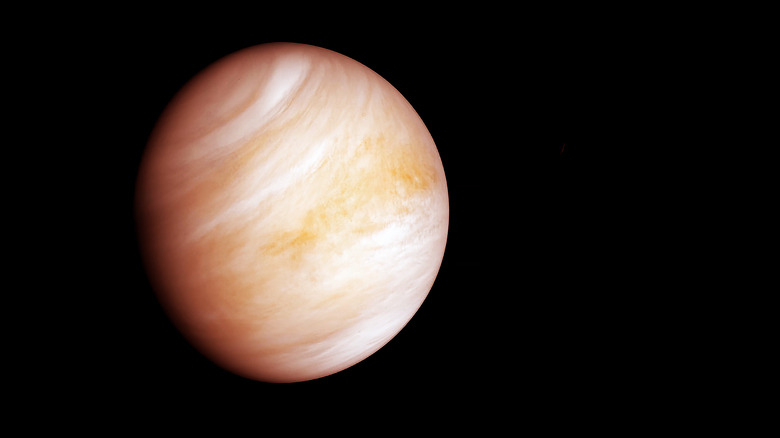The Unbelievable Mission To Venus That You Probably Never Knew About
Venus is as inhospitable a planet as they come. The second rock from the sun is roughly 38 million miles from the Earth at its closest point, according to NASA, and has been the fascination of space enthusiasts and astronomers for as long as humans have looked to the skies.
Venus often appears in the night sky during the fall (via Space), and as such, it's been viewed for centuries by humans looking to understand their purpose and place in the grand scale of the cosmos. While NASA has launched a few missions to capture images and data about the planet in the past, interest in Venus has largely fallen out of favor in deference to dreams of future Martian landings — The current NASA Artemis rocket program is built on the premise of creating a more hospitable launch vector in pursuit of finally landing humans there.
A couple of years ago, however, scientists discovered the production of a chemical called phosphine on Venus, which has led to the conclusion that something (likely microbial) must be alive and producing this excretion (via The New York Times).
The Earth-shattering finding may rewrite our collective understanding of the universe itself and spark greater efforts to land on our much closer neighbor to investigate. But little-known terrestrial missions have indeed already touched down on the planet's surface before, and it might be surprising to discover what the unmanned craft found after making their landings.
The Soviet Venera program landed four probes on Venus' surface
In 1975 and 1982, the Soviet space program successfully landed four of its Venera probes on the surface of Venus (Venera 9 and 10 in 1975, and Venera 13 and 14 in 1982), with each lander successfully capturing and transmitting images back to Earth. In total, Space reports that eight landers successfully reached the surface of Venus in some form or another.
As a result of the toxic environment of the planet, each lander was bombarded by a chemical atmosphere. Many of the probes lost key communications infrastructure upon entry, but dramatic monochrome and color images were retrieved from the successful four. The stunning reality of these images is that the rocky formations appearing in muted yellow hues seem as if they could have been taken on a remote slice of our own home, as noted by Planetary.
The Soviet program to study Venus is truly awe-inspiring, but it often goes unnoticed because the Soviet Union famously buried public acknowledgment of failed missions. Although records remain, it wasn't always an easy task to find data surrounding many of the Venera probes that didn't touch down on our distant neighbor.
Similarly, while these missions began in the '60s, by the time images were captured, American astronauts had already walked on the moon in six separate landings. The so-called space race had been won, reducing interest in anything the Soviet adversary might achieve out there in the great beyond.
NASA is working to reboot exploration of Venus as we speak
Equally exciting is the talk of rebooted NASA exploration of the yellow planet (via NASA).
In addition to renewed interest from NASA, private companies that have developed space-capable technologies are getting in on the hype. A New Zealand-based firm, Rocket Lab, has been working through development stages since at least 2020 and intends to launch a new probe to search for the potential life that might be waiting on Venus (via The New York Times).
The NASA mission scope, for its part, revolves around seismic and atmospheric changes that reimagined Venus as it now exists. NASA scientists believe that Venus probably once looked much like Earth, including oceanic environments and an atmosphere that resembled our own. It's thought that volcanic activity may be responsible for all or most of these immense changes to the biology and geological condition of the planet, considering the amazing density of volcanoes across the surface. Likewise, Venus exhibits planet-wide volcanic minerality that is estimated to be younger than 300 million years, as reported by Eos.
A return to prominence for Venus-centric exploration is a victory for all space enthusiasts. The planet shares so much in common with our own and might provide crucial clues surrounding climate science, alternative life in our universe, and much more. The implications of potentially finding multiple lifeforms in a single solar system and many others that may be waiting are truly unfathomable.


